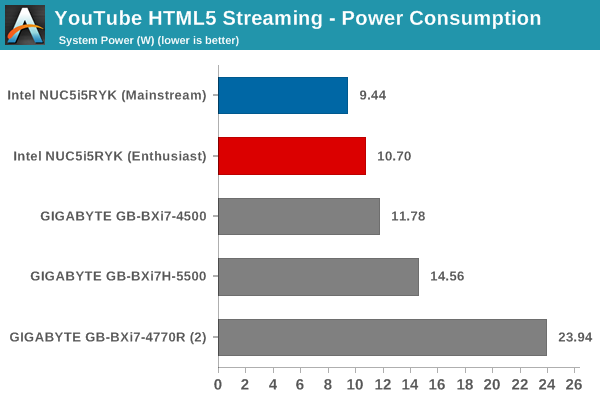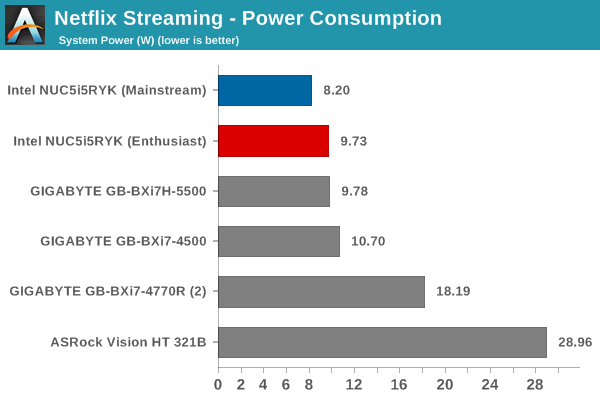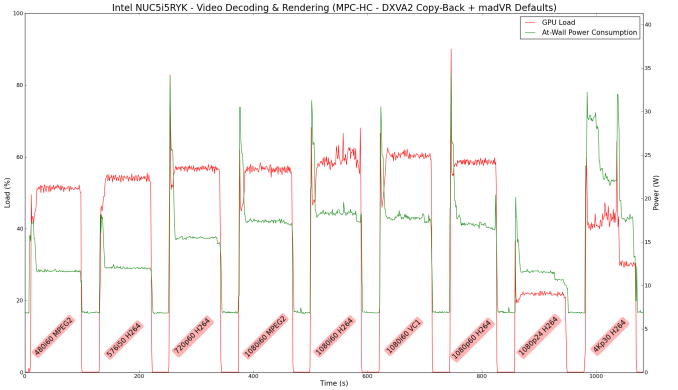Intel NUC5i5RYK Review: A Broadwell-U UCFF PC for Enthusiasts
by Ganesh T S on February 20, 2015 8:00 AM ESTHTPC Credentials
The NUC5i5RYK is a UCFF PC, but, thanks to the 15W TDP CPU inside, it doesn't require a noisy thermal solution. Subjectively speaking, the unit is silent for most common HTPC use-cases. Only under heavy CPU / GPU loading does the fan become audible. In our investigation, recent software improvements in the software chain for playback on Windows have lightened the stress considerably. The NUC5i5RYK definitely makes a good HTPC for folks who don't want to pay the premium for a passively cooled system.
Refresh Rate Accurancy
Starting with Haswell, Intel, AMD and NVIDIA have been on par with respect to display refresh rate accuracy. The most important refresh rate for videophiles is obviously 23.976 Hz (the 23 Hz setting). As expected, the Intel NUC5i5RYK has no trouble with refreshing the display appropriately in this setting.
The gallery below presents some of the other refresh rates that we tested out. The first statistic in madVR's OSD indicates the display refresh rate.
Network Streaming Efficiency
Evaluation of OTT playback efficiency was done by playing back our standard YouTube test stream and five minutes from our standard Netflix test title. Using HTML5, the YouTube stream plays back a 720p encoding. Since YouTube now defaults to HTML5 for video playback, we have stopped evaluating Adobe Flash acceleration. Note that only NVIDIA exposes GPU and VPU loads separately. Both Intel and AMD bundle the decoder load along with the GPU load. The following two graphs show the power consumption at the wall for playback of the HTML5 stream in Mozilla Firefox (v 35.0.1).

GPU load was around 13.46% for the YouTube HTML5 stream and 2.92% for the steady state 6 Mbps Netflix streaming case.
Netflix streaming evaluation was done using the Windows 8.1 Netflix app. Manual stream selection is available (Ctrl-Alt-Shift-S) and debug information / statistics can also be viewed (Ctrl-Alt-Shift-D). Statistics collected for the YouTube streaming experiment were also collected here.

For similar OTT streaming workloads, the NUC5i5RYK unit consumes slightly lower power at the wall compared to the corresponding Haswell NUC. That said, it is difficult to quantify how much of this is due to Broadwell moving down to 14nm. Other components such as the WLAN adapter, DRAM and even the power supply have changed between the two compared units. That said, the Core i5 U-based Broadwell NUC is more power-efficient for these workloads compared to the Core i7 U-based BRIX units.
Decoding and Rendering Benchmarks
In order to evaluate local file playback, we concentrate on EVR-CP and madVR using the mainstream configuration (which has the 1600 MHz DRAM). We already know that EVR works quite well even with the Intel IGP for our test streams. In our Broadwell BRIX s review, we found the HD Graphics 5500 to be incapable of downscaling 4kp30 to 1080p using default madVR settings. We didn't have much hopes for HD Graphics 6000 and our fears were confirmed when similar results were obtained with the NUC5i5RYK initially using the LAV Filters DXVA 2 Copy-Back mode in MPC-HC 1.7.8.
One of the odd aspects that we found in the course of the 4kp30 playback and downscaling process using madVR was that the GPU loading never went above 70%, but approximately half the frames were getting dropped. A careful analysis of the OSD revealed that the split queue was simply not able to keep up (with queues prior to that in the OSD being kept close to full). madVR's split queue copies the decoded frames from the GPU RAM to system RAM and then back to GPU RAM. However, this process seemed to be too slow for 4Kp30 content on the Intel IGP. Just as we were about to wrap up testing of the decoding and rendering aspects, LAV Filters 0.64 was released with huge improvements in DXVA Copy-Back performance. We repeated our benchmarks after overriding the in-built LAV filters of MPC-HC 1.7.8 with LAV Filters 0.64. 4Kp30 downscaling with madVR default settings worked without any dropped frames.
Usually, we suggest usage of the QuickSync decoder built into LAV Video Decoder whenever playback with an Intel IGP machine is desired. However, HEVC decode acceleration using DXVA (implemented partially in software) is available only in the DXVA2N and DXVA2 Copy-Back modes for Broadwell. Hence, we no longer recommend setting the default codec in LAV Video Decoder to Intel QuickSync.
In our earlier reviews, we focused on presenting the GPU loading and power consumption at the wall in a table (with problematic streams in bold). This time around, we decided to represent the GPU load and power consumption in a graph with dual Y-axes. Nine different test streams of 90 seconds each were played back with a gap of 30 seconds between each of them. The characteristics of each stream are annotated at the bottom of the graph. Note that the GPU usage is graphed in red and needs to be considered against the left axis, while the at-wall power consumption is graphed in green and needs to be considered against the right axis.
Points of concern would be GPU loading being consistently above 85 - 90%, but there is no such case in the two scenarios tested above. Power consumption at the wall is less than 15 W for even the most complicated streams when using EVR-CP, while madVR with DXVA2 Copy-Back decoding averages around 20 W for the higher complexity streams involving scaling for fast frame rate or high-resolution content.


















83 Comments
View All Comments
cjs150 - Friday, February 20, 2015 - link
I am a confirmed HTPC user, I have 2 in the house. One, more powerful, is used to rip Blu rays down to NAS, (plus play, Netflix/Amazon Prime, Web browsing) the other is used simply to play movies, browising, word processing and "Old" gaming - I am a big fan of Total War, old versions.Total silent operation is a must. I do not care how quiet the fan is, in soft parts of movie playback I can hear it.
The old i3 NUC, in a fanless case, makes for an excellent low power HPTC. A Broadwell U will be as good.
My problem is then I am not sure even that power is necessary for most HTPC use where simply streaming from NAS or similar external disk. For the next HTPC I am looking forward to reviews of Intels Bay Tree on a stick, so small it could be stuck behind my AV receiver
edzieba - Friday, February 20, 2015 - link
Having 'too much' power for an HTPC has two main advantages:1) Interface speed. This is both for actual rendering of the interface bells & whistles, and for populating large directories when browsing.
2) CODEC futureproofing. H.265 is on the horizon, and Hi10p H.264 has some very nice benefits in bitrate reduction (or better perceptual quality at the same bitrate), but low power hardware that relies on fixed-function decoder blocks will be left high and dry. Even if they DO have a FFB for a desired CODEC, it may not be sufficient to playback all files (e.g. the number of Level 4.0 h.264 decoders that can't handle full-bitrate Blu Ray streams).
Kutark - Tuesday, February 24, 2015 - link
I'm not sure you realize how little processing power is actually used for rendering. Even now on an old dual core pentium my htpc barely hits 10% utilization on one core while watching h.264 stuff at 1080p. My second htpc which has a ~$55 amd 5xxx series card does most of it via the video card, which also is nowhere even close to being taxed.This setup is WWWAAAYYYY past the needs of any kind of streaming/media/htpc. At these price ranges you can actually build a pretty decent desktop with a dedicated graphics card. Yes, it won't be this small, but you will actually have real graphics performance (i.e. a gtx 960 or r9 280, etc).
yankeeDDL - Friday, February 20, 2015 - link
Wouldn't you consider an AMD-based system a better option for an HTPC? Asking as I am considering one.I recently bought an AMD-based laptop and I am extremely pleased with it as I find it much more effective for casual gaming and, frankly, the CPU performance gap with Intel is "irrelevant" for HTPC use (at least the one I have in mind).
cjs150 - Friday, February 20, 2015 - link
YankeeDDL: Short answer is yes, AMD laptop in many cases is a much better HTPC (unless it has a fan!)But will it look good with the rest of your AV kit? My main HTPC is in a HDPLEX 3 case, which looks great (but pricey), my second HTPC is an i3 NUC in a Tranquil fanless case - again fits right into the AV style.
I guess it depends on what you want. Edzieba is clearly much more of a power user of an HTPC than I am. That does make him right and me wrong (or vice versa), just different. But I have yet to find any user of an HTPC who, with all else being equal, would want to have fans in the HTPC if it could run fanless
Flunk - Friday, February 20, 2015 - link
So you're saying an AMD laptop isn't a better HTPC then? Qualifying it with "unless it has a fan" kinda negates the possibility entirely.
BlueBlazer - Saturday, February 21, 2015 - link
Fans have one big problem, dust accumulation and can lead to clogging (in the cooling vents) which can cause overheating.owan - Friday, February 20, 2015 - link
Its not about being a power user... he's talking about why more cpu punch can be a good thing. If you don't have a fixed function decode block for a new codec and your CPU is too crappy to do it in software, then you need to buy a new CPU and mobo. If bay trail on a stick can't do h.265 you're screwed if you try to play h.265 content, but a broadwell NUC might be able to do it in software (assuming it can't decode in hardware... which it may)BlueBlazer - Saturday, February 21, 2015 - link
Agree, I ran into that problem years ago especially with Hi10p (10-bit H.264) which requires software decoding. Those low power slow CPUs (like AMD E-350 and Atom 330) just would not be able to decode it smoothly. Broadwell already has H.265 as well as 10-bit H.265 and VP9 support in its latest drivers: http://techreport.com/news/27677/new-intel-igp-dri...rmullns08 - Friday, February 20, 2015 - link
cjs150: Interesting that you bring up the HDPLEX 3 case. I currently use a D54250WYKH, but have one major complaint with it being the power supply. I don't use mine as much for HTPC, but do use it for an audio setup (Schiit Modi2 Uber/Magni2 Uber and JBL LRS305), and the power supply is so noisy. I've found that the PSU leaks noise on the negative side, into the chassis which is not properly isolated or grounded. Connecting the DAC results in noise shooting through the system even before the USB cable makes actual contact with the NUC. I've tried different surge protectors, relocating devices onto different outlets to no avail. The other day I actually ordered the HDPLEX linear power supply to hopefully resolve the issue once and for all.